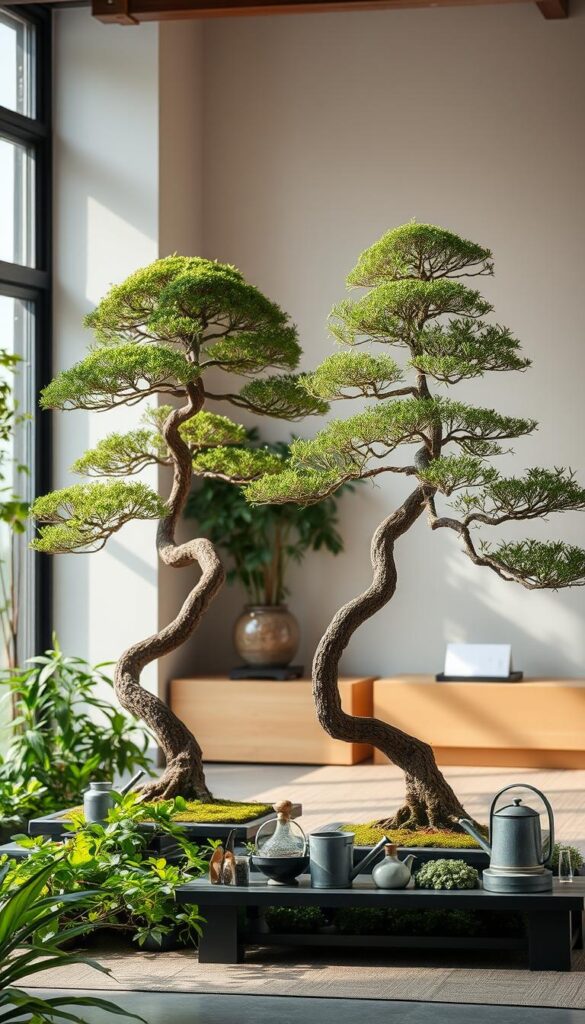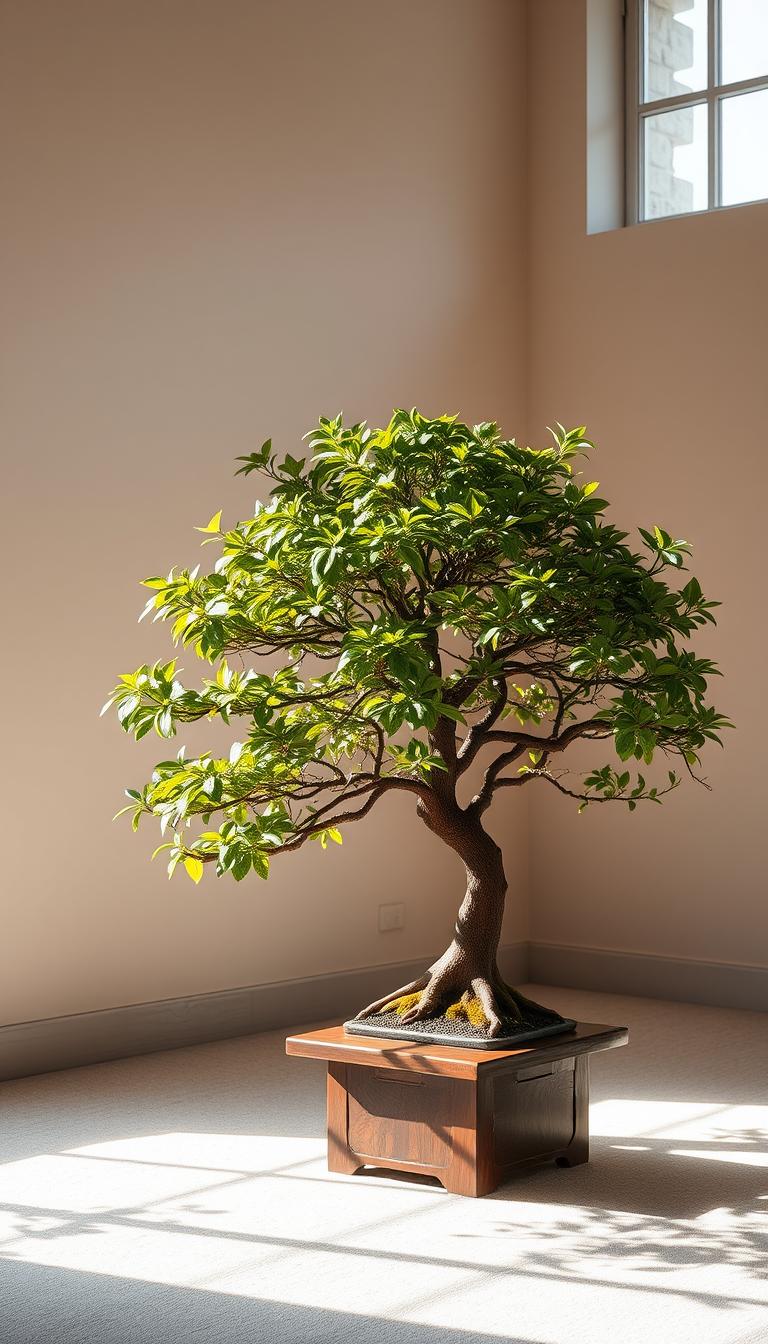I’ve always been captivated by the art of nurturing bonsai trees indoors. It’s a unique challenge that combines patience, precision, and a deep connection with nature. These miniature wonders thrive in small pots, but their care requires attention to detail, especially when it comes to water, soil, and nutrients.
For those new to this hobby, it’s important to understand that not all species are suited for indoor environments. Tropical bonsai, like the resilient Ficus, are ideal choices because they adapt well to indoor conditions and can tolerate lower humidity. This guide is designed to help you navigate the basics, from selecting the right plant to mastering care techniques.
Understanding the dynamics of water and soil is key to long-term success. By following these tips, you can transform your space into a thriving indoor oasis. Every tree’s journey is unique, and it’s the small details that make the biggest difference.
Introduction to Indoor Bonsai Cultivation
My journey into the world of indoor bonsai began with curiosity and a touch of skepticism. Could I really nurture these miniature marvels in my home? The answer, I discovered, lies in understanding the delicate balance of light, water, and time.
Discovering the Art and Personal Journey
Early on, I learned that success with indoor bonsai trees hinges on selecting the right species. Tropical varieties like Ficus and Schefflera are favorites among experts, as they adapt well to indoor conditions and require less maintenance. These species thrive under controlled light periods and are more forgiving for beginners.
The role of light cannot be overstated. Natural light is ideal, but artificial light can be a reliable substitute. I experimented with different light periods to find the perfect balance for my Ficus, ensuring it received enough illumination without overexposure.
| Light Type | Benefits | Considerations |
|---|---|---|
| Natural Light | Promotes healthy growth and vibrant color | Requires placement near sunny windows; may need shading in intense sunlight |
| Artificial Light | Provides consistent illumination and flexibility in placement | May require adjustment of intensity and duration to mimic natural cycles |
Every bonsai tree is a work in progress, and the journey is as rewarding as the result. By understanding and respecting the needs of your bonsai, you can create a thriving indoor oasis. Stay tuned for more practical tips and insights to guide you on your bonsai journey.
Choosing the Right Bonsai Species for Your Home Environment
Selecting the perfect bonsai species for your home can make all the difference in their health and your enjoyment. With so many options available, it’s crucial to choose one that thrives in indoor conditions.
Tropical vs Temperate Varieties
Tropical species are ideal for indoor care. They love the stable temperatures and humidity levels found in most homes. On the other hand, temperate species need a period of dormancy, making them less suitable for indoor environments.
Recommended Species: Ficus, Schefflera, and More
- Ficus and Schefflera are top choices due to their adaptability and low maintenance.
- Dwarf Jade is another excellent option, known for its small leaves and resilience.
- Avoid temperate species like pines and junipers, as they require outdoor dormancy.
When selecting a bonsai, consider the light and temperature near your window. Proper pot and soil conditions are vital for healthy growth. Visiting a specialized nursery can provide valuable guidance. Remember, the right species ensures steady and sustained growth, making your indoor bonsai journey a success.
Insider Secrets for Growing Bonsai Trees Indoors
One of the most critical aspects of nurturing bonsai indoors is understanding how to maximize light and maintain the right environment. These insider tips will help you create the perfect conditions for your plants to thrive.
Maximizing Natural and Artificial Light
To ensure your plants get enough light, place them near a bright, south-facing window. Supplement with fluorescent or LED lights, especially during darker months. Avoid placing them near drafts or direct radiator heat to prevent stress.
Maintaining Ideal Humidity and Temperature
Use humidity trays or mist daily to keep the environment moist. Consistent temperatures are vital—cooler in winter and warmer in spring. Species like Schefflera need careful conditions to avoid issues like leaf drop.
- Position plants near bright windows but away from direct heat.
- Use artificial lights to supplement natural light, especially in winter.
- Employ humidity trays or misting to maintain moisture levels.
- Adjust temperature care from spring to winter for optimal health.
- Ensure stable conditions with optimal light for healthy growth.

By following these tips, you can prevent common problems and help your plants flourish indoors. Remember, stable conditions and proper light exposure make a significant difference in their health and vitality.
Watering, Soil, and Fertilization Practices for Long-Term Growth
Mastering the art of watering, soil selection, and fertilization is essential for the long-term health of your indoor bonsai tree. These practices require careful attention to detail to ensure your tree thrives in its home environment.
Avoiding Overwatering and Nutrient Deficiencies
One of the most common mistakes in caring for an indoor bonsai tree is overwatering. This can lead to root rot, which can be detrimental to your tree’s health. On the other hand, under-watering can slow down the tree’s growth and development. It’s crucial to find the right balance.
To determine if your tree needs water, check the soil moisture by gently digging a finger into the soil about an inch deep. If the soil feels dry, it’s time to water. Avoid following a rigid watering schedule, as this can lead to overwatering. Instead, adapt your watering routine based on the temperature and humidity levels in your home.
The soil mix you use plays a vital role in the health of your tree. A well-draining soil mix is essential to prevent waterlogged roots. I recommend using a mix that includes ingredients like pumice, scoria, or akadama, as these materials promote proper drainage and aeration. These components help maintain a healthy root system, which is crucial for the tree’s overall well-being.
Fertilization is another critical aspect of indoor bonsai tree care. Feeding your tree with a balanced fertilizer during the growing season ensures it receives the necessary nutrients. However, it’s important not to over-fertilize, as this can harm the tree. Dilute the fertilizer to half the recommended strength to avoid burning the roots. Apply the fertilizer every two weeks during the spring and summer months when the tree is actively growing.
Temperature and moisture levels in your home also play a significant role in your tree’s health. Most indoor bonsai trees prefer daytime temperatures between 65-75°F and slightly cooler nights. Maintaining consistent temperature levels helps regulate the tree’s metabolic processes, ensuring it grows steadily and remains healthy.
- Water your tree when the top inch of soil feels dry to the touch.
- Use a well-draining soil mix to prevent root rot.
- Fertilize regularly but avoid over-fertilization.
- Monitor and adjust your care routine based on your home’s conditions.
By following these guidelines, you can create an optimal environment for your indoor bonsai tree to thrive. Remember, every tree is unique, so it’s important to observe and adapt your care routine accordingly. With time and practice, you’ll become more attuned to your tree’s needs, ensuring it remains healthy and vibrant for years to come.

Troubleshooting Common Bonsai Care Challenges
As I continue on my bonsai journey, I’ve learned that every tree tells a story through its health. Identifying signs of stress or disease early can make a significant difference in its survival and vitality.
Identifying Signs of Stress and Disease
One of the first signs of stress in a bonsai is yellowing or blackening of leaf tips, often indicating overwatering or poor drainage. I’ve noticed that nutrient deficiencies can also cause discoloration or stunted growth. Maintaining proper humidity levels is crucial, as dry air can lead to weakened immune systems in plants.
- Discoloration or stunted growth may signal nutrient deficiencies.
- Inadequate humidity can weaken a plant’s immune system.
- Early detection of disease symptoms is key to timely intervention.
Effective Repotting and Root Care Solutions
When repotting, I always choose pots with drainage holes and use a well-draining soil mix to support healthy root systems. The age and species of the tree can affect its reaction to repotting, so it’s important to research specific needs. For example, younger trees may adapt more easily than older ones.
- Use pots with drainage holes to prevent waterlogged roots.
- Opt for soil mixes that promote aeration and proper drainage.
- Consider the age and species when repotting to minimize stress.
By addressing these common challenges with practical solutions, you can create a thriving environment for your bonsai. Remember, every tree is unique, so it’s important to tailor your care routine to its specific needs. With patience and attention to detail, you’ll master the art of nurturing your bonsai and enjoy the rewards of this fulfilling hobby.
Parting Thoughts on Your Indoor Bonsai Journey
As I reflect on my journey with these miniature wonders, I’m reminded of the profound connection we build with nature. Every day, adapting to their condition and needs becomes a rewarding challenge. While species like elm and juniper thrive outdoors, tropical varieties like Ficus and Schefflera flourish indoors with proper care.
Patience is key. Managing dormancy for certain species and understanding their type of care can lead to remarkable results. It’s a journey of trial and error, where each small success brings us closer to mastery.
I encourage you to stay committed, observe your plants, and adjust your techniques. Every tree has unique requirements, and understanding them is a lifelong learning process. Thank you for joining me on this journey. I hope you continue to nurture your passion and share your progress. Happy growing!
